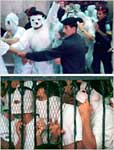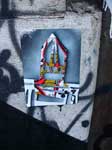
NYT Magazine:
Egypt’s most famous crackdown got under way at a neon floating disco, the Queen Boat, docked on the wealthy Nile-side island of Zamalek, just steps from the famously gay-friendly Marriott Hotel. In the early-morning hours of May 11, 2001, baton-wielding police officers descended upon the boat, where men were dancing and drinking. Security officials rounded up more than 50 of them — doctors, teachers, mechanics. Those who were kept in custody became known among Egyptians as the Queen Boat 52. The detained men were beaten, bound, tortured; some were even subjected to exams to determine whether they had engaged in anal sex. In the weeks that followed, official, opposition and independent newspapers printed the names, addresses and places of work of the detained. Front pages carried the men’s photographs, not always with black bars across their eyes. The press accused the men of sexual excesses, dressing as women, devil worship, even dubious links to Israel. Bakry’s newspaper, Al Osboa, helped lead the charge.
The Queen Boat was just the beginning. Agents of the Department for Protection of Morality, a sort of vice squad within the Ministry of Interior’s national police force, began monitoring suspected gay gathering spots, recruiting informants, luring people into arrest via chat sites on the Internet, tapping phones, raiding homes. Today, arrests and roundups occur throughout the country, from the Nile Delta towns of Damanhour and Tanta to Port Said along the Suez Canal and into Cairo.
Here.

































